I am training a model in multi class classification to generate texts. Below is a sample of the dataset.
| state | district | month | rainfall | max_temp | min_temp | max_rh | min_rh | wind_speed | advice |
|---|---|---|---|---|---|---|---|---|---|
| Orissa | Kendrapada | february | 0.0 | 34.6 | 19.4 | 88.2 | 29.6 | 12.0 | chances of foot rot disease in paddy crop; apply urea at 3 weeks after transplanting at active tillering stage for paddy;...... |
| Jharkhand | Saraikela Kharsawan | february | 0 | 35.2 | 16.6 | 29.4 | 11.2 | 3.6 | provide straw mulch and go for intercultural operations to avoid moisture losses from soil; chance of leaf blight disease in potato crop; ....... |
Below is my code through which the model is made.
def create_model():
input1 = tf.keras.layers.Input(shape=(1,), name='state')
input2 = tf.keras.layers.Input(shape=(1,), name='district')
input3 = tf.keras.layers.Input(shape=(1,), name='month')
input4 = tf.keras.layers.Input(shape=(1,), name='rainfall')
input5 = tf.keras.layers.Input(shape=(1,), name='max_temp')
input6 = tf.keras.layers.Input(shape=(1,), name='min_temp')
input7 = tf.keras.layers.Input(shape=(1,), name='max_rh')
input8 = tf.keras.layers.Input(shape=(1,), name='min_rh')
input9 = tf.keras.layers.Input(shape=(1,), name='wind_speed')
xz= [input1, input2, input3, input4, input5, input6, input7, input8, input9]
x1= layers.Dense(128, activation='relu')(input1)
x2=layers.Dense(128, activation='relu')(input2)
x3=layers.Dense(128, activation='relu')(input3)
x4=layers.Dense(128, activation='relu')(input4)
x5=layers.Dense(128, activation='relu')(input5)
x6=layers.Dense(128, activation='relu')(input6)
x7=layers.Dense(128, activation='relu')(input7)
x8=layers.Dense(128, activation='relu')(input8)
x9=layers.Dense(128, activation='relu')(input9)
base_model = layers.Add()([x1,x2, x3, x4, x5, x6, x7, x8, x9])
first_output = layers.Dense(30, name='output_1')(base_model)
second_output = layers.Dense(30, name='output_2')(base_model)
third_output = layers.Dense(30, name='output_3')(base_model)
fourth_output = layers.Dense(30, name='output_4')(base_model)
fifth_output = layers.Dense(30, name='output_5')(base_model)
models = tf.keras.Model(inputs=xz,
outputs=[first_output, second_output, third_output, fourth_output, fifth_output])
return models
The code for my model compilation.
model=create_model()
optimizer = tf.keras.optimizers.Adam(learning_rate=0.01)
model.compile(optimizer=optimizer,
loss={'output_1': 'categorical_crossentropy',
'output_2': 'categorical_crossentropy',
'output_3': 'categorical_crossentropy',
'output_4': 'categorical_crossentropy',
'output_5': 'categorical_crossentropy'},
metrics={'output_1':tf.keras.metrics.Accuracy(),
'output_2':tf.keras.metrics.Accuracy(),
'output_3':tf.keras.metrics.Accuracy(),
'output_4':tf.keras.metrics.Accuracy(),
'output_5':tf.keras.metrics.Accuracy()})
Finally, the problem I am facing, the loss and accuracy. Loss is too high.
Epoch 499/500
2/2 [==============================] - 0s 11ms/step - loss: 66362.0130 - output_1_loss: 5827.9458 - output_2_loss: 10478.4935 - output_3_loss: 16566.5957 - output_4_loss: 16831.8887 - output_5_loss: 16657.0967 - output_1_accuracy: 0.0000e+00 - output_2_accuracy: 0.0000e+00 - output_3_accuracy: 0.0000e+00 - output_4_accuracy: 0.0000e+00 - output_5_accuracy: 0.0000e+00
Epoch 500/500
2/2 [==============================] - 0s 11ms/step - loss: 66362.0130 - output_1_loss: 5827.9458 - output_2_loss: 10478.4935 - output_3_loss: 16566.5957 - output_4_loss: 16831.8887 - output_5_loss: 16657.0967 - output_1_accuracy: 0.0000e+00 - output_2_accuracy: 0.0000e+00 - output_3_accuracy: 0.0000e+00 - output_4_accuracy: 0.0000e+00 - output_5_accuracy: 0.0000e+00
Kindly help me and correct me where I am wrong. I am total newbie to this field.
Alternative Model Update
model = tf.keras.Sequential([
feature_layer,
layers.Dense(128, activation='relu'),
layers.Dense(128, activation='relu'),
layers.Dropout(.1),
layers.Dense(150),
])
opt = Adam(learning_rate=0.01)
model.compile(optimizer=opt,
loss='mean_squared_error',
metrics=['accuracy'])
It have the [5,30] shaped input reshaped to [150].
